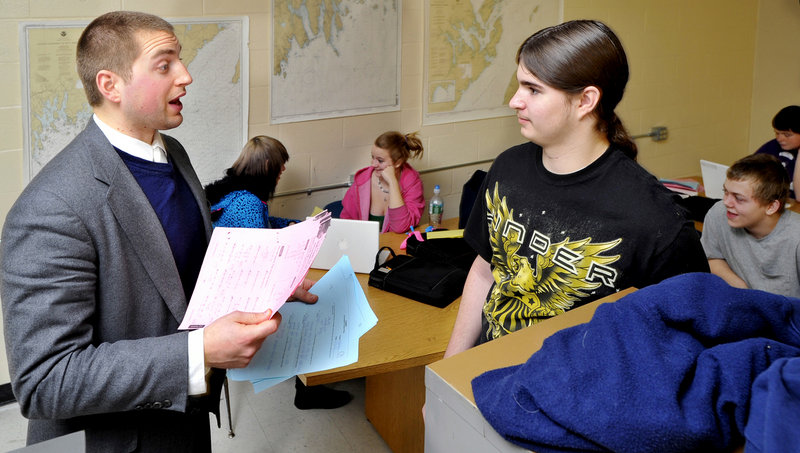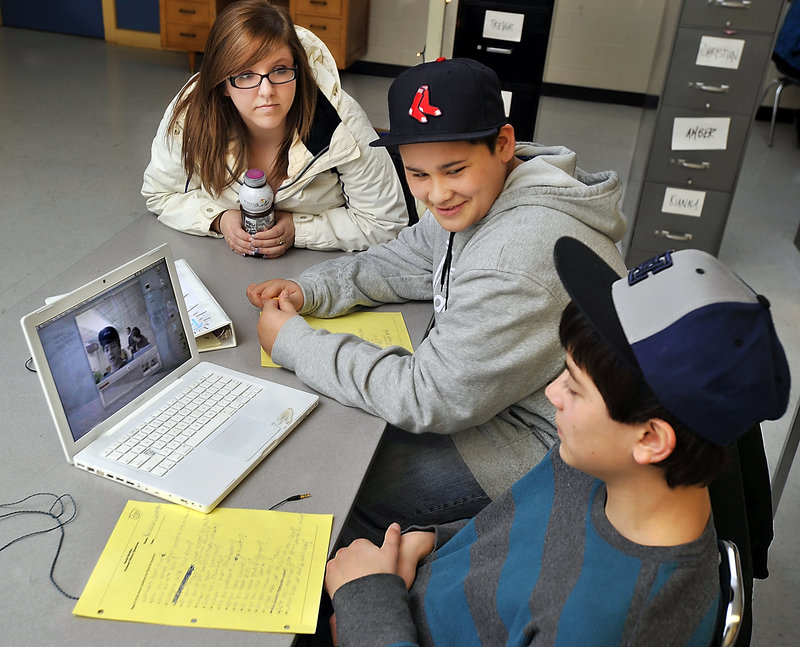WESTBROOK — Last week, Alex Howe got a perfect score on his mid-term math exam.
Last year, he might have skipped school and missed the exam.
“I got the highest grade in the class,” Howe said proudly.
Howe is succeeding in a new program at Westbrook High School that supports freshmen who are at risk of dropping out. He’s one of 16 students in the School for Success, a program that school officials hope to expand to include sophomores next year.
In developing the program, school officials targeted eighth-graders at Westbrook Middle School who had missed a lot of school and struggled academically, said Principal Marc Gousse. The goal was to bridge the gap between middle school and high school that trips up many at-risk students.
Early results are promising. During the first semester, September through January, School for Success students, as a whole, attended 88 percent of their classes and earned credit for 97 percent of their courses. Eleven of the students are boys; five are girls.
“These guys are motivated to be in the program and earn the credits they need to graduate,” said John Morgan, the teacher of School for Success.
In one classroom with one teacher, the School for Success provides a nurturing environment that highlights students’ individual strengths and helps them gain skills they need to succeed in mainstream classes, said Bruce Dyer, a substance abuse counselor who heads the district’s dropout prevention committee.
Beyond teaching language arts, social studies, math and science, Morgan guides his students in staying focused and organized, listening and following directions, being respectful and on time, and coping with whatever challenges they face at home and elsewhere.
“The success of this program so far indicates that the kids are getting something they need,” Dyer said. “We need to deliver education differently. We’ve been doing it with the same system for 100 years, and we know a lot more about how kids learn today.”
The program is part of the school district’s overall effort to reduce its dropout rate, which fell from 7.75 percent in 2005-06 to 1.67 percent in 2009-10, Gousse said.
That means about 12 of the high school’s 736 students left during the last school year without graduating or enrolling in another school or diploma program, Gousse said. He and other school officials want that number to be even lower.
“We want to keep them in school,” Gousse said. “If they’re not in school, what are they doing, and what are the ramifications for society now and in the future?
“The manufacturing jobs that once made it possible to raise a family without a high school diploma don’t exist anymore. So we can either spend the time and resources now or spend a lot more down the road.”
School for Success cost about $70,000 this year. Gousse financed it with existing funding for two half-time teaching positions. Adding a second teacher to extend the program to sophomores would double the cost and the number of students served, he said. Saco & Biddeford Savings gave $1,500 to support the program this year.
School for Success is modeled after Casco Bay High School in Portland, which promotes experience-based, interdisciplinary learning projects and close student-teacher relationships.
For social studies, for instance, the students have visited the Westbrook Historical Society several times to learn about local history and landmarks, and they’re working on a history project that will include interviewing elders about their experiences.
This is Morgan’s first job as a classroom teacher. He graduated from Westbrook High in 2001 and the University of Southern Maine after that.
At 27, he also has two years of experience as an education technician with the Sebago Educational Alliance, a day-treatment program for students with significant emotional and behavioral needs.
And he’s a Coast Guard Reserve member.
Morgan bases his lessons on curriculum plans developed by the mainstream freshman faculty at Westbrook High. His students take one mainstream class each day. Eventually, he wants his students to be able to transition into mainstream classes. The high school also has an alternative education program for juniors and seniors.
Morgan’s approach in the classroom is different from that of most mainstream teachers. He makes sure his instructions and expectations are clear and measured. He leads students through lessons one step at a time.
He avoids long lectures, because students’ attention wanders and their impulse control breaks down. Instead, he gets them working on lessons and gives one-on-one assistance.
He also provides stability and consistency, and demands accountability, He keeps track of foul language and interruptions with marbles in a jar, and rewards good behavior with free time and other incentives.
“Everything is incremental,” Morgan said. “I realized early on that I couldn’t just lecture to them. For whatever reason, these guys haven’t had a positive experience in school. Some of them would probably survive in mainstream classes, but they wouldn’t thrive.”
Other students would probably drop out if they were forced into mainstream classes, but that’s not a viable option in Morgan’s mind. He wants all of his students to succeed. Students like Alex Howe make him believe that it’s possible.
Howe likes coming to school now, in large part because he’s learning. And he feels like he belongs.
“We do a lot more work in class and don’t have as much homework,” Howe said. “We have one class, one teacher, and all my stuff is here. I’m a good kid and I’m getting good grades here.”
Staff Writer Kelley Bouchard can be contacted at 791-6328 or at: kbouchard@pressherald.com
Copy the Story Link
Send questions/comments to the editors.




Success. Please wait for the page to reload. If the page does not reload within 5 seconds, please refresh the page.
Enter your email and password to access comments.
Hi, to comment on stories you must . This profile is in addition to your subscription and website login.
Already have a commenting profile? .
Invalid username/password.
Please check your email to confirm and complete your registration.
Only subscribers are eligible to post comments. Please subscribe or login first for digital access. Here’s why.
Use the form below to reset your password. When you've submitted your account email, we will send an email with a reset code.